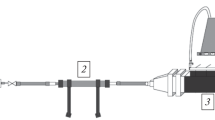Abstract
With the high-voltage electrostatic theory and numerical analysis, the dynamics of conductive and nonconductive particles under high-voltage electrostatic coupling fields was studied. The oscillation behavior of the conductive particle between the corona electrode and ground electrode was analyzed and its oscillation amplitude was S m=(t a +t s ) · v m/2. It was found that there was the “lift-off voltage (U lo)” for the conductive particle between the electrostatic electrode and ground electrode. The concepts of “critical charged rotational speed (n*)”, “detaching critical rotational speed of nonconductive particle (n′)” and “ratio of voltage and distance between surface of electrodes (U/D)” were presented and their criteria were established. The trajectories of the conductive particles under the coupling fields of the corona electrode, electrostatic electrode and ground electrode were simulated by the computer. The simulative results were in good agreement with the experimental ones. This research enriches the high-voltage electrostatic theory and provides a theoretic basis for optimization of operating parameters and structure design of high-voltage electrostatic separator.
Similar content being viewed by others
References
Lawver J E, Dyrenforth W P. Electrostatic Separation in Electrostatics and Its Applications. Moore A D, ed. New York: Wiley, 1973. 221–249
Knoll F S, Lawver J E, Taylor J B. Electrostatic separation, In: Ullmann’s Encyclopedia of Industrial Chemistry. 5th ed. Weinheim: VCH, 1988. B2, 20-1–20-11
Ralston O C. Electrostatic Separation of Mixed Granular Mmaterials. Amsterdam: Elsevier, 1961. 20–25
Roman M, Radu M, Emil S, et al. Electrostatic treatment of bean seeds. IEEE Trans on Indust Appl, 1999, 35(1): 208–212
luga A, Morar R, Samuila A, et al. Electrostatic separation of metals and plastics from granular industrial wastes. IEE Proc.-Sci. Meos Technol, 2001, 48(2): 47–54
Shunli Z, Forssberg Er. Optimization of electrodynamic separation for metals recovery from electronic scrap, Resour, Conserv Recycl, 1998, (22): 143–162
Veit H M, Diehl T R, Salami A P, et al. Utilization of magnetic and electrostatic separation in the recycling of printed circuit boards scrap. Waste Manag, 2005, 25: 67–74
Li J, Lu H Z, Guo J, et al. Recycle technology for recovering resources and products from waste printed circuit boards. Environ Sci Technol, 2007, 41(6): 1995–2000
Lu H Z, Li J, Guo J, et al. Electrostatics of spherical metallic particles in cylinder electrostatic separators/sizers. J Physs D-Appl Phys, 2006, 39: 4111–4115
Li J, Xu Z M, Zhou Y H. A model for computing the trajectories of the conducting particles from waste printed circuit boards in corona electrostatic separators. J Hazardous Mater, 2008, 151: 52–57
Li J, Xu Z M, Zhou Y H. Application of corona discharge and electrostatic force to separate metals and nonmetals from crushed particles of waste printed circuit boards. J Electrostat, 2007, 65: 233–238
Lu H Z, Li J, Guo J, et al. Movement behavior in electrostatic separation: recycling of metals materials from waste printed circuit board. J Mater Proc Technoly, 2008, 197(1–3): 101–108
Pauthenier M. La physique des porces e’lectrostatiques et leurs applications. Grenoble: CNRS, 1960. 279–287
Wu Y, Castle G S P, Inculet I I, et al. Induction charge on freely levitating particles. Powder Technol, 2003, 135–136: 59–64
Dascalescu L, Iuga A, Morar R, et al. Charging of particulates in the corona field of roll-type electroseparators. J Phys D-Appl Phys, 1994, 27: 1242–1251
Ангелов А И, Ве⌕ещагини П, Ершов В С. Physical electrostatic separation. Moscow Mineral (in Russian), 1983, 160
Lu H Z. High-voltage Electrostatic separation for fragmentized printed circuit boards. Dissertation (in Chinese). Shanghai: Shanghai Jiao Tong University, 2006. 3
Author information
Authors and Affiliations
Corresponding author
Additional information
Supported by the National High Technology Research and Development Program of China (“863” Program) (Grant No.2006AA06Z364), Program for New Century Excellent Talents in University (Grant No. NCET-05-0404) and the Research Fund for the Doctoral Program of Higher Education of China (Grant No.200060248058)
Rights and permissions
About this article
Cite this article
Xu, Z., Li, J., Lu, H. et al. Dynamics of conductive and nonconductive particles under high-voltage electrostatic coupling fields. Sci. China Ser. E-Technol. Sci. 52, 2359–2366 (2009). https://doi.org/10.1007/s11431-008-0198-2
Received:
Accepted:
Published:
Issue Date:
DOI: https://doi.org/10.1007/s11431-008-0198-2




